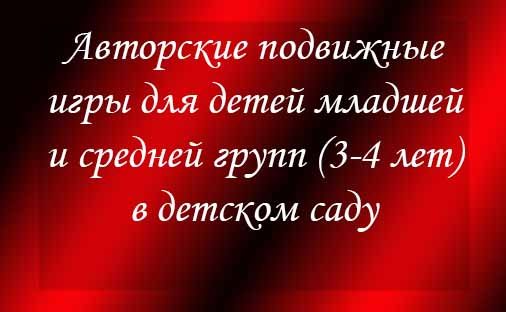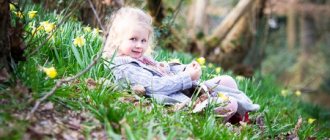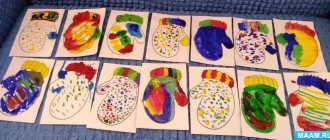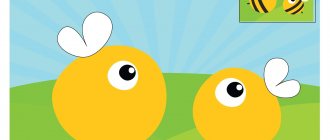Summary of the outdoor game “Hen and Chicks” (1st junior group)
Summary of the outdoor game “Hen and Chicks” (1st junior group)
Tasks:
Educational:
Continue to form ideas about poultry.
To develop expressiveness of movements, the ability to convey the simplest actions of some characters (imitation of movements).
To develop the ability to walk and run without bumping into each other, with coordinated, free movements of the arms and legs.
Educational:
Develop a desire to play together with the teacher in simple outdoor games.
Develop attention and memory in the game.
Develop coordination of movements, orientation in space.
Develop coordination of joint actions in outdoor games.
Wellness:
Contribute to the creation of a favorable psychological climate.
Instill interest in physical activity by creating special conditions (attributes, equipment).
Educational:
Cultivate a desire to listen to works of art without visual accompaniment.
Preliminary work:
Examination of plot pictures from the “Bird Yard” series, toys;
Reading fiction: poetry by T. Chudinova “The Mother Hen”, L. Lukanova “Chickens”; T. Lavrova “Cockerel”, fairy tales by K. Ushinsky “Cockerel with his family”;
Performing an improvised dance “The Cockerel's Song” (music by R. Rustamov, lyrics by L. Mironov) using hats and masks;
Outdoor games: “Crested hen.”
Techniques and methods of work:
Verbal: artistic expression, questions, encouragement;
Visual: showing how to perform an action;
Practical: outdoor game.
Planned result:
- They respond emotionally to the activities proposed by adults, imitate his actions, and accept the game task.
- They know how to perform movements as shown by the teacher.
- Game actions are accompanied by speech.
- Listen to poems that are accessible in content.
Game attributes and equipment:
mother hen mask (for an adult, later for a child), chicken masks (for children), rope or bench.
| Content | Dosage | Organizational and methodological instructions |
| Progress of the game: On one side of the site (group or group area) there is a “chicken coop” fenced off with a rope, where “chicks” (children who sit on a bench or stand) are placed with a “mother hen” teacher. To the side is a “big bird” (first an adult, later one of the kids). The teacher - the “hen” leaves the “chicken coop”, crawls under the rope and goes in search of food. | 3 min. | Educator: Guys, let's play the game “Hen and Chicks.” I will be the “mother hen” and you will be my “chickens”. And “the big bird - the raven” will play with us, today it will be (“Alyosha”). Let's start the game. You “chickens” sit at home and wait for me to call you, and I go out for a walk. The teacher walks around the playground, raising his legs high and reproducing the actions of a chicken, flapping his arms like wings: The chicken went out for a walk, Pinch some fresh grass. |
Summary of a developmental lesson for children of the second group of early age “Hen with chicks”
Educational activity for children 2 – 3 years old “Hen with Chicks”
I offer educational activities for children aged 2-3 years. It may be of interest to primary school teachers, early childhood educators and caring mothers.
I.
Greeting “Hello palms” II. Gymnastics during the lesson : 1. Logori, “We wash our hands”, “The bunny jumped” • Develop correct speech breathing • Develop coordination of movements • Develop the ability to quickly switch from one type of activity to another • form the concepts of tempo, rhythm, the ability to transform and move expressively in accordance with the chosen image 2. Articulation gymnastics “Swing”, “Jam”, “Brushing teeth” III. Lesson “Hen with Chicks” Objectives: • introduce the chicken family • encourage birds to use onomatopoeia • teach to distinguish colors: red, yellow, green • develop fine motor skills • learn to compare two objects. Materials: grain in a box, hay-nest, 2 eggs, TOYS: chick, hen, rooster. Illustrations, masks of a rooster, hen and chicks, the sound of a chicken. Educator: Who came to us? Who talks like that? Children's answer - chicken Teacher: takes out a chicken toy Teacher: Hello, chicken - Ryaba. It's good that you came to us. Tell me where and with whom you live. Chicken: I live in a chicken coop. (Picture 1. chicken coop) I have a very large family and we all live together. Every day our owner brings us delicious grains of wheat, corn, sunflower (show box with grain). – invite the child to touch the hard grains, sort the grains by type - sunflower, wheat and corn. Chicken: Look how soft my nest is. (show a nest made of hay, offer to touch the soft hay) - the chicken “sits in the nest”, quietly placing a wooden or boiled real egg. To the children: look what our hen has in her nest? - children's answers (egg) did you lay an egg for us? Thank you. Development of fine and medium motor skills - tactile play The CHICKEN hid various objects in a box of grain. Guys, try to guess what is there by touch. Game "Find the egg". Place various items + a wooden egg in a box with wheat. The child puts his hand into the grain and takes out an object that reminds him of an egg to the touch. A toy chicken appeared in the hen's nest. PE-PEE, PEE-PEE-Pee Chicken: KO-KO-KO, my chickens, Game “Poultry Yard” Goal: development of active speech - the child’s independent use of onomatopoeia KO-KO-KO, KU-KA-RE-KU in speech , pee-pee. Equipment: toys - hen, cockerel, chick. Progress of the game: MASKS to choose from - Let's play birdies. The hen and chicks are walking around the yard, collecting grains. They ate and began to talk. KO-KO-KO - says the chicken, go drink some water. PEEP - the chickens squeak - let's run, mommy. KOO-KA-RE-KOO! - the cockerel cries, I found you a worm. So we talked! Encourage your child to repeat the birds' conversation after you. When pronouncing onomatopoeia, make sure that the baby pronounces them in one exhalation and does not take in air while pronouncing. B addresses the children: let's compare the chicken and the cockerel, how they are similar and how they differ. (based on an illustration of a chicken coop or a toy) How many legs does a rooster have? -2, what about the chicken? Same 2 - same How many wings does a rooster have? 2, what about the chicken? Also 2 - the same Both the hen and the cockerel have feathers, and the beaks are the same, each has 2 eyes. HOW do they differ? - tails and combs. The cockerel has a long multi-colored tail. He walks importantly between his relatives and shouts KOO-KA-RIKU And now, you and I will be chickens and mother - a chicken. An outdoor game accompanied by music. A hen and her chicks walk through the puddles, raise their paws higher, and sing a song: A flock of chickens follow the “hen,” raising their legs higher, flapping their wings. Chorus: Co-co-co, co-co-co, We are walking far. Standing still, they sing “ko-ko-ko” and hit their sides with their wings. They walked in the clearing and pecked at sweet grains. And wherever you go, you won’t find sweeter grains. They squatted down and “pecking the grains.” At the end of the verse a “cockerel” appears. Finger games. We depict a cockerel's comb - hands in a lock, open all fingers one by one and squeeze again: “Petya, Petya, Cockerel, Show me your comb.” Like this and like this: Now your palms, now your fist.” It’s the same with the chicken, only the fingers are half-bent: “The grain pecks: “Ko-ko!” Don't go far! We connect each chicken finger in turn with the thumb and say “Pee-pee, pee-pee, Where are my brothers? Game which egg is the chicken made from? Children are given pictures of chickens and eggs of different sizes and colors. The task is to choose the right egg for the chicken, the right size, which is called the color of the egg. Objectives: learn to distinguish primary colors, sizes large, medium, small. IV. Creative workshop A. “Feed the chickens” • Learn to roll balls, press balls onto paper. • Develop fine motor skills. B. Dough cockerel. Show the children the dough prepared in advance. Talk about its qualities - The dough is soft and warm, made from flour and water, it can be kneaded, made into pies and buns. Give the children a medium-sized piece of dough and invite them to play with it - knead it, make a bun. Give them the opportunity to play as much as they want. You can accompany the actions with the words: I’m kneading, kneading the dough, There’s room in the oven, I’m baking, I’m baking a loaf! Come on pies! Let's! Make a bird. The child inserts feathers into the bird.
We recommend watching:
Summary of an educational activity for older preschoolers Educational game for younger preschoolers Flower Mannequin for hairstyles with your own hands Summary of GCD on the topic: Winter for children of the preparatory group
Similar articles:
Summary of GCD in the 1st junior group by February 23
Author's outdoor games for children of primary and secondary groups (3-4 years old) in kindergarten
Nomination: original outdoor games for preschoolers of primary and secondary groups of preschool educational institutions.
Abstract: The proposed games can be played in the morning during exercise, at thematic educational activities, during entertainment, in a group in the evening. The games use small rhyming poems that help children develop speech and enrich their vocabulary.
- Game "Cockerel and Children"
Goal: to facilitate children's quick orientation in the gym.
Progress of the game
The cockerel is sitting on a chair. Children go to him and say the words:
Petya - petya - cockerel
You are, of course, our friend.
Now don't yawn
Catch up with your friends.
Children run around the hall, the cockerel catches up, and whoever it catches up with moves aside and performs the exercises shown in the diagram.
- "Prickly hedgehog"
Goal: developing the ability to quickly act on a signal.
Progress of the game
Children find a place for themselves in the hall, whoever wants to “hide” where they want. A child in a hedgehog’s cap walks and says the words: “I am a prickly gray hedgehog, don’t touch me with your hand, I will quickly catch up with you and prick you a little.”
The children run away to the music, and the “hedgehog child” catches up. Children can save themselves from the “hedgehog” by raising their hands up.
- "Goat and kids"
Goal: to teach children to conduct a dialogue and quickly run away after the signal.
Progress of the game
Children stand in front of a goat, in a hoop, with masks on a rope lying near their feet. The goat (with mask) is at a distance. They are having a conversation.
Goat: - who are you, dear guys?
Children: - we are funny kids !
Goat :- I'm a playful goat and a bit of wolfberry.
I want to play with you and catch up with the little goats.”
Children put on masks and quickly run away as soon as the music starts. "Goat" is catching up. Whoever he catches, the “kid” goes into his hoop.

Author's outdoor games for children of primary and secondary groups (3-4 years old) in kindergarten
- "Duck with ducklings"
Goal: uniting children in joint coordinated actions.
Progress of the game
Children put on duckling masks and stand on the “lake” marked with blue circles, three children at a time. “Duck – Child” also puts on a mask or cap. He walks around the hall and sings: “quack-quack-quack, I’ve been looking for you for a long time, friends.” Where are you guys, cute ducklings?:
Presenter: “Then the ducklings run out and run away from the duck.”
"Children - ducklings" run away. Whomever the “duck” has caught up with, he leaves and stands on the “lake”.
Nomination: original outdoor games for physical activity of preschoolers. Author: Tatyana Aleksandrovna Ocheredko Position: physical education instructor of the highest qualification category Place of work: MADOU combined type kindergarten No. 99 Location: Tomsk region, Tomsk
Date modified: December 10, 2022 Date published: December 10, 2017


